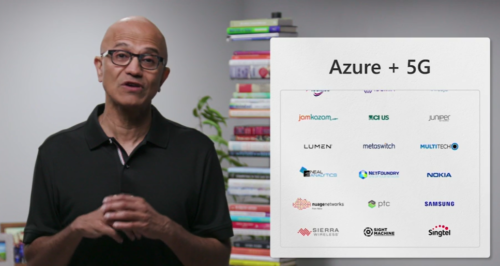
Microsoft CEO Touts New Azure Solutions and More at Inspire
Microsoft used the opening session on July 19 at its Inspire 2022 event, once again held online, to highlight several new and enhanced Azure and other solutions.
Amid a “time of so many constraints, every day, 400,000 partner organizations around the world are applying technology to make a real difference,” according to Satya Nadella, Microsoft CEO and chairman.
“Over the past few years, we’ve talked extensively about digital transformation but, today, we need to go beyond that, from talking about digital transformation to delivering on the digital imperative for every organization,” he told viewers.
And he advised them: “The time is now. It’s what will make the difference between organizations that thrive and those that get left behind. Every organization in every industry will continue to infuse digital technology into every business process and function so that they can do more with less. The case for doing this has never been more urgent or more clear. In fact, I would say it’s existential.”
 He predicted that “the next 10 years are not going to be like the last 10,“ with digital technology being a “deflationary force in an inflationary economy,” he said.
He predicted that “the next 10 years are not going to be like the last 10,“ with digital technology being a “deflationary force in an inflationary economy,” he said.
Nadella met with a CEO a couple of weeks ago who explained how technology was being used to save money at a Latin American plant and use the savings to avoid raising prices, while addressing “one of the greatest challenges facing the region: food insecurity,” Nadella said.
A Coca-Cola bottler in Europe, meanwhile, has “used our technology to lower their energy consumption, the other crisis we are facing today,” Nadella said
“Doing more with less doesn’t mean working harder or longer,” Nadella warned. “That’s not the way we are going to scale but it does mean applying technology to amplify what you are able to do across an organization so you can differentiate and build resilience,” he said.
What this all “comes down to [is] how we can help you use the Microsoft cloud to help your customers overcome today’s challenges and emerge stronger,” he told viewers.
Nadella went on to highlight what he said were several “digital imperatives for every organization to do more with less and how we are creating new opportunity for you.”
“It starts at the infrastructure layer,” he noted. “Leaders in every industry are accelerating their migration to the cloud and it’s not just lift and shift. Ninety-five percent of new digital workloads will be deployed on cloud native platforms for 2025,” he projected.
Meanwhile, as information technology (IT) and operational technology (OT) are “coming together,” he said the cloud is “foundational to how organizations will be competitive going forward.”
“Every customer I speak with is clear eyed about aligning their IT investments to scale with demand and moving to the cloud allows them to just do that, converting their spending” from capital expenses to operating expenses, he said. That “creates an opportunity for all of you to help organizations by providing your expertise,” he said, adding: “It’s all about helping customers drive operational efficiency, deliver faster, time to value and reduce costs.”
He told viewers: “You can measure success by how much compute you’re using and how efficiently you’re using it. I can’t say this enough. It’s all about doing more with less.”
To help accomplish that, Microsoft is “building the next generation multi-cloud, multi-edge infrastructure to support this,” he said.
The company now has “more data center regions than any other cloud provider,” Nadella pointed out.
And that will only improve. “I’m excited to announce that, over the next year, we will launch 10 new data center regions in 10 markets, spanning four continents, delivering faster access to services and helping address data residency needs,” Nadella said.
To achieve all this, sustainability will “be key to our approach,” he said, pointing out: “We’re adding new capabilities to address our data centers to reprocess used equipment, drastically reducing waste. In fact, we are committed to reusing over 90% of our cloud computing hardware by 2025. Servers might find a second home in schools or job training programs. And the reclaimed memory cards might be used in electronic toys or game systems.”
Meanwhile, one “critical aspect of our strategy is to work closely with local partners to meet the sovereignty needs of public sector customers in specific markets,” including SAP in Germany, he noted.
“Today, we are going even further to help partners around the world serve public sector customers,” he also pointed out. “We’re announcing the Microsoft Cloud for Sovereignty, which provides policies, controls and technologies that’ll enable customers to meet a government’s specific data, sovereignty, security and privacy requirements.”
In a blog post the same day, Corey Sanders, corporate VP, Microsoft Cloud for the company’s Industry and Global Expansion Team, described Microsoft Cloud for Sovereignty as a “new solution that will enable public sector customers to build and digitally transform workloads in the Microsoft Cloud while meeting their compliance, security and policy requirements.” The Microsoft Cloud for Sovereignty, “combined with strategic partners, can support the digital transformation of government customers unlike any other cloud provider in the world,” he added.
It was built on “what we have come to expect from the public cloud: improved resiliency, agility, cost and scale economics,” Nadella went on to say in his session. “This builds on our innovation with Azure confidential computing, which is already helping customers bring their most sensitive workloads to the cloud,” he noted.
Additionally, “new Azure confidential computing capabilities, including the ability to encrypt data while it’s in use without changing your application, make it easier for you to work with customers in regulated industries,” Nadella told viewers.
“With new confidential virtual machines, as well as Azure confidential ledger, your customers can have more confidence their data is being protected during its entire life cycle,” he explained.
“The combination of our core capabilities around confidential computing and sovereignty make our cloud very unique,” according to Nadella.
“Our differentiation goes beyond that,” he said, noting that, with the Azure Arc bridge, “you’re bringing the power of Azure anywhere so that you can build apps with Azure services that can run across on-premise, edge and multi-cloud environments.”
With Azure for Operators, meanwhile, Microsoft is “bringing computing to the 5G edge,” he said, noting: “We have the largest partner ecosystem of anyone in the industry helping to deliver the next generation private wireless solutions.”
 Along with Microsoft partners, the company is also “extending our infrastructure beyond our planet with Azure Orbital unlocking scenarios like earth observations for precision farming, global communications for remote connectivity and the satellite fleet operations for sending commands to orbit in real time,” he told viewers. Orbital is a Ground Station as-a-Service that Microsoft said provides communication and control of a satellite.
Along with Microsoft partners, the company is also “extending our infrastructure beyond our planet with Azure Orbital unlocking scenarios like earth observations for precision farming, global communications for remote connectivity and the satellite fleet operations for sending commands to orbit in real time,” he told viewers. Orbital is a Ground Station as-a-Service that Microsoft said provides communication and control of a satellite.
At Inspire, Microsoft also announced that its new Azure Space Partner Community will help partners scale their space solutions on Azure.
The “ubiquitous fabric from 5G to space will enable a new generation of modern connected applications that’ll create opportunities for our partners to transform entire industries and more than 95 percent of the Fortune 500 trust Azure for their most mission critical workloads,” Nadella said. “Leaders in every industry use our cloud infrastructure,” he added.
Nadella went on to talk about “empowering pro and citizen developers” and Microsoft’s approach to digital and app innovation.
“Today every company is a digital company,” he noted. “In fact, there’s more demand for developers in some key industries, like public sector, education, energy, retail, entertainment and transportation, than even the tech industry itself,” he said.
That, he noted, “represents a tremendous opportunity for all of you,” he said. “Organizations are eager to adopt DevOps, which is fast becoming the default way to deploy code to production, creating massive opportunity for all of you to help them adopt these new processes,” he explained.
Azure solutions, which also include Visual Studio, provide the “most complete platform and the most trusted cloud to help developers go from idea to code, code to cloud, and cloud to the world,” he said.
By 2025, he went on to predict, 70% of new applications deployed for the enterprise will use low code or no code tools, up from under 25%.
